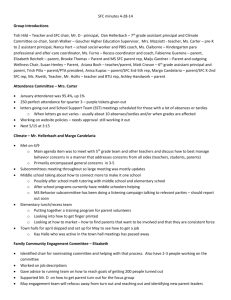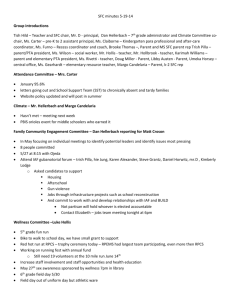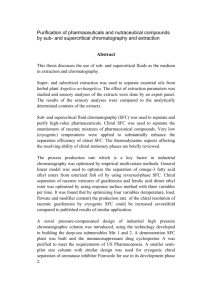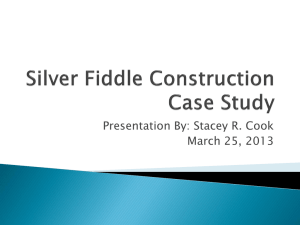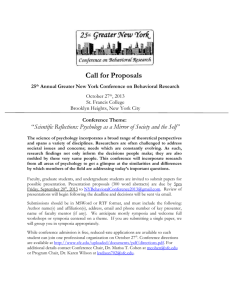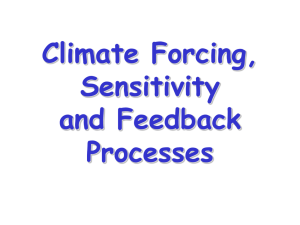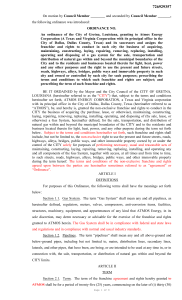Lab
advertisement
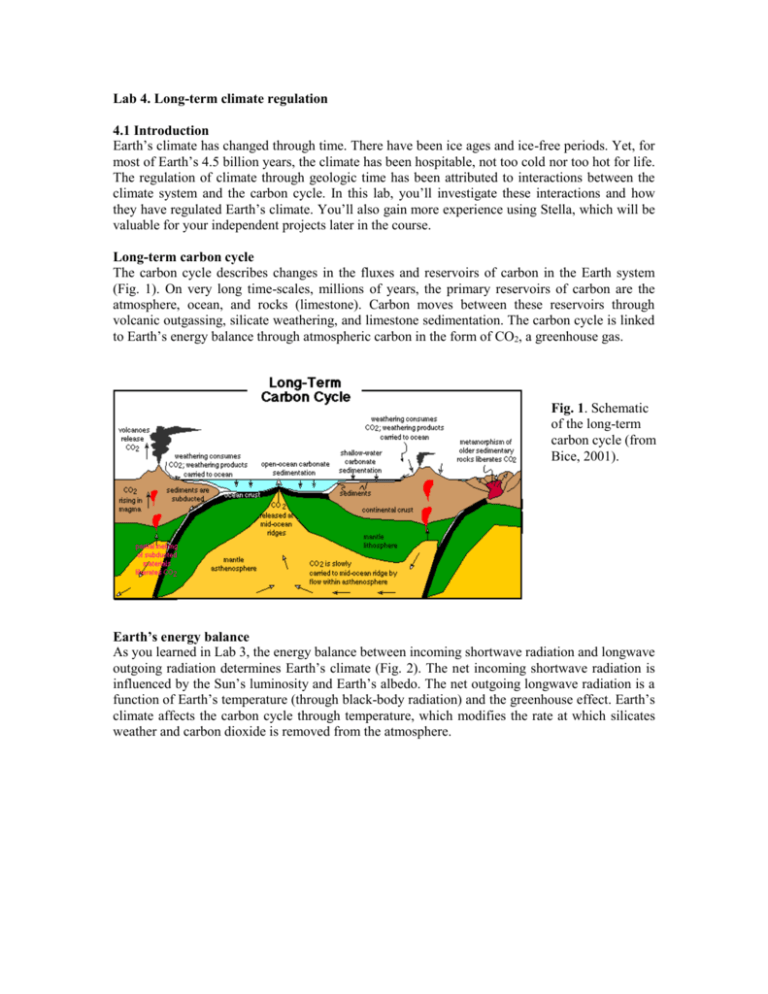
Lab 4. Long-term climate regulation 4.1 Introduction Earth’s climate has changed through time. There have been ice ages and ice-free periods. Yet, for most of Earth’s 4.5 billion years, the climate has been hospitable, not too cold nor too hot for life. The regulation of climate through geologic time has been attributed to interactions between the climate system and the carbon cycle. In this lab, you’ll investigate these interactions and how they have regulated Earth’s climate. You’ll also gain more experience using Stella, which will be valuable for your independent projects later in the course. Long-term carbon cycle The carbon cycle describes changes in the fluxes and reservoirs of carbon in the Earth system (Fig. 1). On very long time-scales, millions of years, the primary reservoirs of carbon are the atmosphere, ocean, and rocks (limestone). Carbon moves between these reservoirs through volcanic outgassing, silicate weathering, and limestone sedimentation. The carbon cycle is linked to Earth’s energy balance through atmospheric carbon in the form of CO2, a greenhouse gas. Fig. 1. Schematic of the long-term carbon cycle (from Bice, 2001). Earth’s energy balance As you learned in Lab 3, the energy balance between incoming shortwave radiation and longwave outgoing radiation determines Earth’s climate (Fig. 2). The net incoming shortwave radiation is influenced by the Sun’s luminosity and Earth’s albedo. The net outgoing longwave radiation is a function of Earth’s temperature (through black-body radiation) and the greenhouse effect. Earth’s climate affects the carbon cycle through temperature, which modifies the rate at which silicates weather and carbon dioxide is removed from the atmosphere. Fig. 2. Schematic of the climate system (from Bice, 2001). 4.2 Exploring the Long-Term Carbon Cycle A model of the long-term carbon cycle has already been developed for you. This model was also designed by David Bice (2001). Start by opening the Stella model (carboncycle.STM). In its current form, the carbon cycle is not linked to the climate system. This is a good place to start in order to understand how the long-term carbon cycle works without the complicating influence of climate. Check to confirm that your Run Specs are the same as those in Table 1. Run the model. Graph ATMOS C, OCEAN C, LIMESTONE. The model should be in steady state. Note the different sizes of the carbon reservoirs. Table 1. Carbon model run spec parameters. Length of Simulation DT Integration Method 10 (Myrs) 0.005 Runge-Kutta 2 Q4.2A The response time is how long the system takes to re-establish steady state after a perturbation. Double the ATMOS C reservoir from 600 Gt C (gigatons of carbon) to 1200 Gt C. Run the model, again graphing ATMOS C, OCEAN C, LIMESTONE. What is the response time of the long-term carbon cycle? Remember that time here is in million of years. Where did the excess carbon end up? Did it remain in the ATMOS C reservoir? Explain this result. Q4.2B Return the ATMOS C reservoir to its initial condition so that you can test how the model responds to a temperature perturbation. First, make your own prediction. Next, test your prediction. Increase the deltaT external converter to 1. This represents a 1 K (1 °C) increase in global temperature. Run the model. Graph ATMOS C, OCEAN C, LIMESTONE. How did the distribution of carbon between reservoirs change? Why? Explain your answer in terms of changes in carbon fluxes between reservoirs, and support it with results from the model. 4.3 Exploring the Climate System A model of the Earth’s energy balance has already been developed for you as well. This model was designed by David Bice (2001) at Penn State University. Start by opening the Stella model (ebm.STM). This model is slightly, but not much, more complicated than the one that you created in Lab 3. Remember last week, we determined that our model was insufficient to predict surface temperatures accurately because it did not include an atmosphere. This climate model includes and atmosphere, and estimates longwave fluxes in the atmosphere, as well as at the surface. Check to confirm that your Run Specs are the same as those in Table 2. Run the model. Graph SFC TEMP. The model should be in steady state. Table 2. Climate model run spec parameters Length of Simulation DT Integration Method 10 (yrs) 0.01 Runge-Kutta 2 Q4.3A Our primary goal in this lab is to investigate climate-carbon cycle interactions. To begin, explore how the climate system responds to perturbations in the absence of the carbon cycle. Let’s perturb the system by changing the Solar Input, the percent of Sun’s radiation received by Earth. This experiment isn’t entirely unrealistic. Remember that Sun’s luminosity has increased with time. Try values of 99, 98, 97, 95, 80. Use the Numeric Display function to see the solution. Record the change in Earth’s surface temperature (SFC DT). Solar Input 100 99 98 97 95 80 SFC DT 0.00° 4.4. Climate Regulation by Carbon Cycling Now, it’s time to link our carbon cycle model and our energy balance model. This requires a fair amount of manipulation in Stella, excellent practice for you to hone your modeling skills. Start by copying and pasting the entire energy balance model into the window with your carbon cycle model using the tools in the Edit menu. To link the models, you need to make a few modifications: (1) Using the dynamite tool, blast away the SFC DT and external DT converters from the carbon cycle model. (2) Create a radiative forcing converter and connect it to the LW SPACE converter. Also connect the relative atmos C converter to the radiative forcing converter. Double click on the new radiative forcing converter and add the following equation: 5.35*LOGN((relative_atmos_C + 0.0000000000001)/280) This equation defines the relationship between CO2 and radiative forcing. The relationship is logarithmic. As atmospheric CO2 increases, the radiative forcing increases by a smaller and smaller amount. (3) Double click on the relative_atmos C converter. Modify the equation by multiplying by 280 (the pre-industrial concentration of CO2). It should read: (ATMOS_C/600)*280 (4) Modify the LW SPACE equation to include the radiative forcing from the carbon cycle model, and multiply this term by 10 (see explanation in step 6). The equation should be: (60*((ATMOS_TEMP/255)^4) – radiative_forcing)*10 (5) Rename SFC DT_2 to SFC DT. Connect the SFC DT converter to weathering. (6) And, finally, multiply the SW ATMOS, SW SURF, LW ATMOS, LW SURF, and the SFC LW SPACE converters by 10 (put the existing equation in parentheses () first!). This is a little sleight of hand. The energy balance model and the carbon cycle model operate on very different time scales (years versus millions of years). As far as the carbon cycle is concerned, the atmosphere responds immediately. However, Stella requires that the models operate on the same, long time scale. By multiplying the energy balance fluxes by 10, we’re essentially running the climate system on a slightly shorter time scale. This trick isn’t perfect, but will work as long as our focus is the steady state answers. SOLAR INPUT CLOUD COVER radiativ e f orcing CLOUD ALBEDO ATMOS C relativ e atmos C relativ e ocean C SW ATMOS ABS REFLECTED SW OCEAN C ATMOSPHERE 2 weathering LW SPACE SW ATMOS SW SURF SFC ALBEDO relativ e limestone LIMESTONE ATMOS TEMP SURFACE LW SURF melting & metamorphism sedimentation ATMOS dT ~ tectonic pulse LW ATMOS SFC TEMP SFC LW SPACE SFC DT SFC DTx100 Fig. 3. Schematic of the climate-geochemical model in Stella. Check to confirm that your Run Specs are the same as those in Table 3. Also make sure that you returned the Solar Input to 100. Run the climate-geochemical model. Graph SFC TEMP. The model should have a steady state temperature of 288 K. Table 3. Model run spec parameters Length of Simulation DT Integration Method 20 (Myrs) 0.005 Runge-Kutta 2 Q4.4A Let’s compare solutions from our climate model with our climate-geochemical model. As above, perturb the system by changing the Solar Input. Again use values of 99, 98, 97, 95, 80. Record the change in Earth’s surface temperature (SFC DT) in a table. Compare the solutions using the two models. Explain why the solutions are different. Specifically address how climatecarbon cycle interactions affect the final global average temperature. Use graphs to support your answer. Solar Input 100 99 98 97 95 80 SFC DT 0.00° Q4.4B Our climate model is fairly sophisticated, and keeps track of radiation in the atmosphere and at the surface. It also includes cloud albedo, representing the average albedo of the atmosphere, and a surface albedo. Increase the surface albedo (SFC ALBEDO) by 100% from 4/54 to 8/54. Record the SFC DT. What happens to the surface temperature? Explain this change. Support your answer through analyses of changes in other fluxes and reservoirs. Increase the SFC ALBEDO to 24/54. Run the model and record the SFC DT. Explain why the response to a large albedo change differs from a small albedo change. (Hint: review the equation for radiative forcing).
